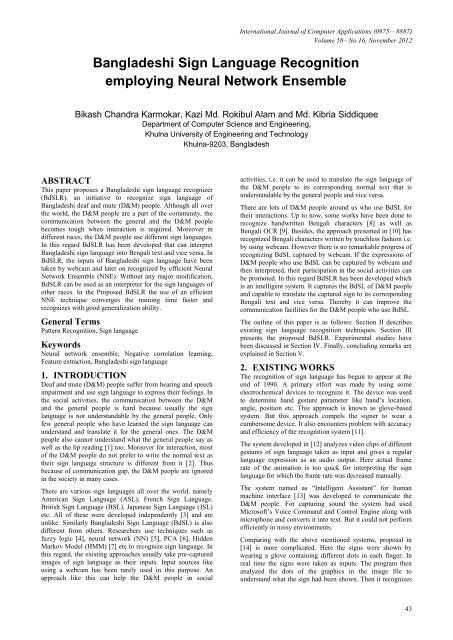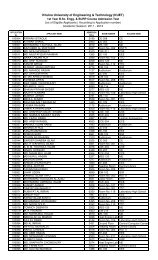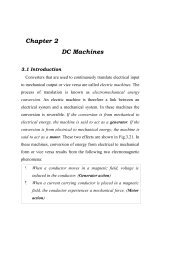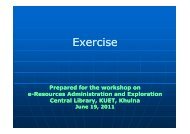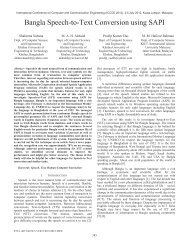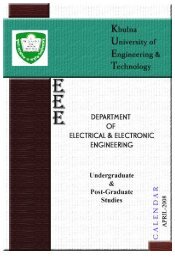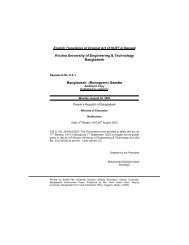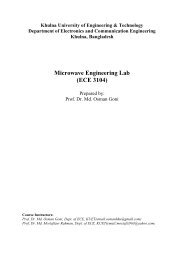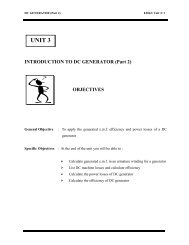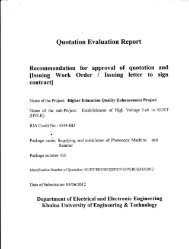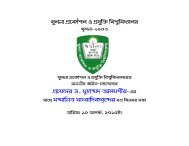Bangladeshi Sign Language Recognition employing Neural ... - KUET
Bangladeshi Sign Language Recognition employing Neural ... - KUET
Bangladeshi Sign Language Recognition employing Neural ... - KUET
- No tags were found...
You also want an ePaper? Increase the reach of your titles
YUMPU automatically turns print PDFs into web optimized ePapers that Google loves.
International Journal of Computer Applications (0975 – 8887)Volume 58– No.16, November 2012<strong>Bangladeshi</strong> <strong>Sign</strong> <strong>Language</strong> <strong>Recognition</strong><strong>employing</strong> <strong>Neural</strong> Network EnsembleBikash Chandra Karmokar, Kazi Md. Rokibul Alam and Md. Kibria SiddiqueeDepartment of Computer Science and Engineering,Khulna University of Engineering and TechnologyKhulna-9203, BangladeshABSTRACTThis paper proposes a <strong>Bangladeshi</strong> sign language recognizer(BdSLR), an initiative to recognize sign language of<strong>Bangladeshi</strong> deaf and mute (D&M) people. Although all overthe world, the D&M people are a part of the community, thecommunication between the general and the D&M peoplebecomes tough when interaction is required. Moreover indifferent races, the D&M people use different sign languages.In this regard BdSLR has been developed that can interpret<strong>Bangladeshi</strong> sign language into Bengali text and vice versa. InBdSLR, the inputs of <strong>Bangladeshi</strong> sign language have beentaken by webcam and later on recognized by efficient <strong>Neural</strong>Network Ensemble (NNE). Without any major modification,BdSLR can be used as an interpreter for the sign languages ofother races. In the Proposed BdSLR the use of an efficientNNE technique converges the training time faster andrecognizes with good generalization ability.General TermsPattern <strong>Recognition</strong>, <strong>Sign</strong> languageKeywords<strong>Neural</strong> network ensemble, Negative correlation learning,Feature extraction, <strong>Bangladeshi</strong> sign language1. INTRODUCTIONDeaf and mute (D&M) people suffer from hearing and speechimpairment and use sign language to express their feelings. Inthe social activities, the communication between the D&Mand the general people is hard because usually the signlanguage is not understandable by the general people. Onlyfew general people who have learned the sign language canunderstand and translate it for the general ones. The D&Mpeople also cannot understand what the general people say aswell as the lip reading [1] too. Moreover for interaction, mostof the D&M people do not prefer to write the normal text astheir sign language structure is different from it [2]. Thusbecause of communication gap, the D&M people are ignoredin the society in many cases.There are various sign languages all over the world, namelyAmerican <strong>Sign</strong> <strong>Language</strong> (ASL), French <strong>Sign</strong> <strong>Language</strong>,British <strong>Sign</strong> <strong>Language</strong> (BSL), Japanese <strong>Sign</strong> <strong>Language</strong> (JSL)etc. All of these were developed independently [3] and areunlike. Similarly <strong>Bangladeshi</strong> <strong>Sign</strong> <strong>Language</strong> (BdSL) is alsodifferent from others. Researchers use techniques such asfuzzy logic [4], neural network (NN) [5], PCA [6], HiddenMarkov Model (HMM) [7] etc to recognize sign language. Inthis regard, the existing approaches usually take pre-capturedimages of sign language as their inputs. Input sources likeusing a webcam has been rarely used in this purpose. Anapproach like this can help the D&M people in socialactivities, i.e. it can be used to translate the sign language ofthe D&M people to its corresponding normal text that isunderstandable by the general people and vice versa.There are lots of D&M people around us who use BdSL fortheir interactions. Up to now, some works have been done torecognize handwritten Bengali characters [8] as well asBengali OCR [9]. Besides, the approach presented in [10] hasrecognized Bengali characters written by touchless fashion i.e.by using webcam. However there is no remarkable progress ofrecognizing BdSL captured by webcam. If the expressions ofD&M people who use BdSL can be captured by webcam andthen interpreted, their participation in the social activities canbe promoted. In this regard BdSLR has been developed whichis an intelligent system. It captures the BdSL of D&M peopleand capable to translate the captured sign to its correspondingBengali text and vice versa. Thereby it can improve thecommunication facilities for the D&M people who use BdSL.The outline of this paper is as follows: Section II describesexisting sign language recognition techniques. Section IIIpresents the proposed BdSLR. Experimental studies havebeen discussed in Section IV. Finally, concluding remarks areexplained in Section V.2. EXISTING WORKSThe recognition of sign language has begun to appear at theend of 1990. A primary effort was made by using someelectrochemical devices to recognize it. The device was usedto determine hand gesture parameter like hand’s location,angle, position etc. This approach is known as glove-basedsystem. But this approach compels the signer to wear acumbersome device. It also encounters problem with accuracyand efficiency of the recognition system [11].The system developed in [12] analyzes video clips of differentgestures of sign language taken as input and gives a regularlanguage expression as an audio output. Here actual framerate of the animation is too quick for interpreting the signlanguage for which the frame rate was decreased manually.The system named as “Intelligent Assistant” for humanmachine interface [13] was developed to communicate theD&M people. For capturing sound the system had usedMicrosoft’s Voice Command and Control Engine along withmicrophone and converts it into text. But it could not performefficiently in noisy environments.Comparing with the above mentioned systems, proposal in[14] is more complicated. Here the signs were shown bywearing a glove containing different dots in each finger. Inreal time the signs were taken as inputs. The program thenanalyzed the dots of the graphics in the image file tounderstand what the sign had been shown. Then it recognizes43
TrainingTestTrainingTestInternational Journal of Computer Applications (0975 – 8887)Volume 58– No.16, November 2012Pre-processingCapturing images ofBdSL using a webcamImage ProcessingConversion of the imagesinto threshold valueNormalizationFeature Extraction<strong>Recognition</strong>Training by NCLComputingtraining errorErroracceptable?YesStop trainingNopin ( F ( n) F(n))( F n F(n)).ijiHere the parameter 0 ≤ ≤ 1 is used to adjust the strength ofthe penalty.4.2 Performance of <strong>Recognition</strong>As mentioned earlier, BdSLR has been trained by 235samples. Here, training has been continued until the error ratehas reached to 0.02. As shown in Fig. 5, the error ratedecreases as the number of training cycles increases and thecurve becomes steady after 2500 training cycles. To gain thebetter performance, we have chosen 3000 training cycles forour experiment.jMatrix representation of theextracted image<strong>Recognition</strong> ofBdSLFig. 4: Block diagram of the proposed BdSLR.4. EXPERIMENTAL STUDIES4.1 Experimental SetupIn the experiment, we have used 47 signs of BdSL as input totrain where each sign has 5 samples that make 47 x 5 = 235samples of pre-defined images of same pixel size. ThenBdSLR can recognize any of 47 of captured BdSL. In thetraining of BdSLR, the NCL [17] learns through adjusting itsweights which is a supervised learning algorithm. Forexample for BdSL signs “অ”, ”ক”, ”১”, ” ২” etc, we havesufficiently trained BdSLR by NCL in an iterative processthat adjust the weights in the mode of pattern-by-patternupdating considering its penalty function. In BdSLR, thechosen architecture of individual NN involved in NCL has30x33 i.e. 990 nodes (after normalization) in input layer andone hidden layer with flexible no. of nodes. Its output layercontains 47 nodes and the training continues until the errorreaches to a certain error level.The output of NCL is a simple averaging of outputs of a set ofNNs which is given byM1,FnM F ini1where M is the number of the individual NNs in the NNE,F i (n) is the output of NN i on the nth training pattern, and F(n)is the output of the NNE on the nth training pattern. NCL usesa correlation penalty term into the error function of eachindividual NN in the NNE so that all the NNs can be trainedsimultaneously and interactively on the same training data set.The error function E i for NN i in NCL is defined byNNN11 12 1Ei Ein ( Fi( n) d(n)) pi( n)N N 2Nn1n1n1where E i (n) is the value of the error function of NN i atpresentation of the nth training pattern. Here, the first term inthe right side of the above equation is the empirical riskfunction of NN i. The second term pi is a correlation penaltyfunction which has the formFig. 5 Training error.Table I shows the performance of the proposed BdSLRsystem. Considering = an arbitrary value and = 0, NCLhas been used to develop BdSLR. Here for = 0, individualNNs are trained independently which is as same as standardback-propagation (BP) algorithm. The table shows that NCLproduces better recognition accuracy in comparison with BPin all perspectives. Moreover, NCL learns faster than BP.No. ofoutputs= 47No. ofsamples47x5 =235Inputpixelsize =30x33Table 1. <strong>Recognition</strong> Performance of BdSLRIterationsTrainingtime (s)Accuracy (%)NCLBPNCL BP152 175 98 95 86 683000 148 183 96 93 80 65156 179 97 91 83 71Average 152 179 97 93 83 684.3 Performance with different NNsinvolved in NCLFor the pursuit of better generalization, NCL has been usedwith different NN architectures to develop BdSLR. In thedomain of the same data space, NCL has been designedconsidering five and ten individual NNs. Table II shows thecomparison of performance of BdSLR among these differentNCL architectures. As training data space is large, NCLconsisting of ten NNs with feature extraction shows the bestaccuracy.45
International Journal of Computer Applications (0975 – 8887)Volume 58– No.16, November 2012Table 2. Performance Comparison of B dSLR WithDifferent ArchitecturesNetwork Type Accuracy (%)NCL with 05 NNs 81NCL with 10 NNs 88NCL with 10 NNs with feature extraction 934.4 DiscussionIn this experiment the capturing process of the images bydetecting hand gesture using the webcam is little bitcumbersome and tedious. Better performance can be achievedby considering the following steps: There should not be any colour in the experimentalenvironment which conflicts with human skin colour. Camera pixels should be high enough for a better qualityof images. Adequate light should be provided while capturing theimages.5. CONCLUSIONIn comparison with existing works, the BdSLR systemproposed in this paper is an advanced initiative to recognizeBdSL. D&M people accustomed with BdSL can be benefittedby the interpretation facility of BdSLR while engaging insocial vital activities. To implement BdSLR, we haveexploited feature extraction [19] along with NCL [17]algorithm for training that is capable enough to perform agood recognition. BdSLR has been implemented involvingdifferent numbers of individual NNs in NCL. Theexperimental results show that NCL with feature extractionyields good recognition accuracy approximately 93%. BdSLRcan be enhanced to learn other sign languages. A future planof improvement is to employ BdSLR to recognize BdSL inreal time.6. REFERENCES[1] Beatrice de Gelder, Jean Vroomen and Lucienne van derHeide, “Face recognition and lip reading in autism”,European journal of cognitive psychology, 1991, Vol.3(1), pp. 69-86.[2] Fudickar, S. and Nurzynska, K., “A user friendly signlanguage chatr” in proceedings of the conference ICL2007.[3] Padden Carol A. and Tom Humphries, “Deaf inAmerica”, in Harvard University Press, 1988.[4] Holden, E.-J., R. Owens and G. Roy, “Adaptive fuzzyexpert system for sign recognition”, in proceedings of theinternational conference on signal and image processing,Las Vegas, USA, 2000, pp.141-146.[5] M.B. Waldron, and S. Kim, "Isolated ASL <strong>Sign</strong><strong>Recognition</strong> System for Deaf Persons," in IEEETransactions on Rehabilitation Engineering, Vol. 3,No.3, 1995, pp. 261-271.[6] H. Birk, T. B. Moeslund, and C. B. Madsen, "Real-time<strong>Recognition</strong> of Hand Alphabet Gesture Using PrincipalComponent Analysis”, in Proceeding of ScandinavianConference on Image Analysis, Finland, 1997.[7] Vogler, C. and D. Metaxas, "Adapting Hidden MarkovModels for ASL <strong>Recognition</strong> by Using three-Dimensional Computer Vision Methods," in Proceedingsof the IEEE International Conference on Systems, Manand Cybernetics SMC97, IEEE Computer Society:Orlando, Florida. 1997, pp. 156-161.[8] Ahmed Shah Mashiyat, Ahmed Shah Mehadi, KamrulHasan Talukder, “Bangla off-line Handwritten Character<strong>Recognition</strong> Using Superimposed Matrices”, ICCIT,2004.[9] U. Pal, “On the development of an optical characterrecognition (OCR) system for printed Bangla script”,Ph.D. Thesis, Indian Statistical Institute, 1997.[10] Bikash Chandra Karmokar, Kazi Md. Rokibul Alam andMd. Kibria Siddiquee, “An Intelligent Approach toRecognize Touchless Written Bengali Characters”International Conference on Informatics, Electronics &Vision (ICIEV), 2012, Dhaka, Bangladesh.[11] Foez M. Rahim, Tamnun E Mursalin, Nasrin Sultana,“Intelligent <strong>Sign</strong> <strong>Language</strong> Verification System – UsingImage Processing, Clustering and <strong>Neural</strong> NetworkConcepts” International Journal of EngineeringComputer Science and Mathematics, ISSN:0976-6146,Vol.1 No.1 January-June 2010.[12] D. Shahriar Hossain Pavel, Tanvir Mustafiz, Asif IqbalSarkar, M. Rokonuzzaman, “Geometrical Model BasedHand Gesture <strong>Recognition</strong> for Interpreting Bengali <strong>Sign</strong><strong>Language</strong> Using Computer Vision”, ICCIT, 2003.[13] Adnan Eshaque, Tarek Hamid, Shamima Rahman, M.Rokonuzzaman, "A Novel Concept of 3D AnimationBased 'Intelligent Assistant' for Deaf People: forUnderstanding Bengali Expressions", ICCIT, 2002.[14] Sohalia Rahman, Naureen Fatema, M.Rokonuzzaman,"Intelligent Assistants for Speech Impaired People",ICCIT, 2002.[15] Sandberg, “Gesture <strong>Recognition</strong> using <strong>Neural</strong>Networks”, 1995.[16] K. Murakami and H. Taguchi, “Gesture <strong>Recognition</strong>using recurrent neural networks”, in proceedings ofCH191 Human factors in Computing Systems, 1991.[17] Y. Liu, X.Yao, “Ensemble learning via negativecorrelation”, <strong>Neural</strong> Networks 12 (1999) pp. 1399–1404.[18] Centre for Disability in Development (CDT), "Manual on<strong>Sign</strong> Supported BangIa," in Computer Vision and ImageUnderstanding, 1-50, 2002.[19] Isabelle Guyon and Andr´e Elissee, “An Introduction toFeature Extraction”, Series Studies in Fuzziness and SoftComputing, Physica-Verlag, Springer, 2006.[20] Melville and Mooney, “Creating Diverse EnsembleClassifiers to Reduce Supervision”, PhD thesis,Department of Computer Sciences, University of Texasat Austin, November 2005.[21] Hafiz T. Hassan, Muhammad U. Khalid and KashifImran, “Intelligent Object and Pattern <strong>Recognition</strong> usingEnsembles in Back Propagation <strong>Neural</strong> Network”,International Journal of Electrical & Computer Sciences(IJECS-IJENS) Vol. 10, No: 06.[22] Robi Polikar, “Ensemble based systems in decisionmaking”, Article IEEE Circuits and Systems Magazines,2006.46


